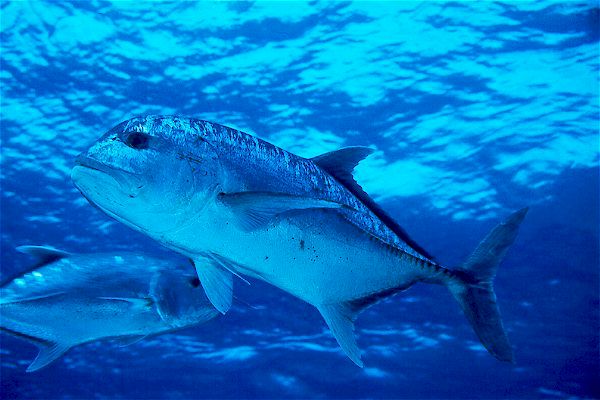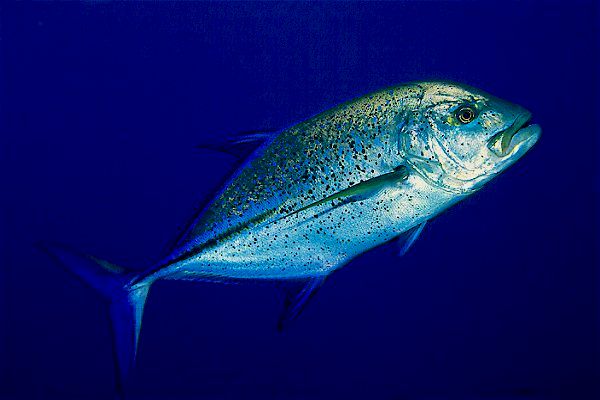| Whipping: Casting Lures Usually done over some sort of reef structure, whipping involves casting a lure out and retrieving it fast and erratically. Local anglers prefer spinning tackle for this method. Large surface plugs or poppers are the most popular lures used by serious whippers, with many fishermen swearing by black pili poppers. Black is a great color but especially good when whipping poppers and lures around rough waters adjacent to rocky or cliff coastlines where the black jumping jack (blenny) lives. Predator fish will often be prowling just under the whitewater waiting for a blenny to get swept off the rocks by a large wave. But an ulua is an opportunistic feeder that will eat just about anything that swims and they are not picky about any particular color. It is good to experiment with different colors when the fish seem to not be taking the lure. For example: I've seen 20 lb. uluas biting good on blue-backed lures when, at the same time, the younger papio were only chasing the pink-backed poppers without actually biting them. Those younger papio were also attacking and getting hooked on yellow-backed pili poppers that a friend was using. So color sometimes does make a big difference. Pencil Poppers, Pili poppers, Chug Bugs, Pop-Queens, and Kaku Lures are all good lures for medium to large fish and there are many other lures on the market. Some people even prefer to make their own out of wooden dowel; certainly the best option for serious ulua whippers who don't want to spend the money on new lures that might break on rocks, get stuck on the reef, crushed by a massive strike or get broken off in the reef by a fish. Just about any lure will work for papio whipping. Smaller fish are caught on small soft plastic lures or just plastic strips which are tied some feet behind a bobber. The bobber is popped to attract fish and the fish bite the lure. This is a great way to catch smaller fish under 2-pounds. Feather jigs in white, pink, yellow, black or just about any color works great for catching papio. Plastic body jigs such as swim baits, paddle tail grubs, and large curly tail grubs work great and come in larger sizes to catch bigger fish. Spoons are also proven fish catchers. Diving crankbaits and stickbaits also work great. Mullet imitations make sense because ulua love striped mullet. Husky jerks look good but a good size ulua might tear one in half or crush the lure with it's powerful jaws. Yo-Zuri Crystal Minnows are popular lures and have taken their share of fish. Normark and Rapala Stainless Steel Magnums are also good lures. But while using all the lures mentioned above, it is important to have a fast and erratic retrieve. Slow retrieves are sometimes ignored by Trevally while fast retrieves can drive them crazy. Whipping With Baits Many people prefer to whip with whole fish as bait and this is a good way to get a lot of strikes. Heavy spinning rods with at least 25# test are used although smaller rods can be used in conjunction with smaller baits. This is generally done over deep reefs where one does not need to worry about snagging bottom. The baits are cast out and reeled in slowly or sometimes reeled in fast to skip them over the surface. The two absolute best baits are small and therefore require small rods in the 12# class to whip with. The best bait is oama, which are baby goatfish (Weke), and which can be caught in the summer with handpoles on shallow sand or sandy reef areas. Oama are by far the best bait for papio and all sorts of other reef fish. They usually are not whipped but rather casted out with a weight to let sit, a method which can be done with heavier line. Few papio will pass up an oama. The next best bait are the blennies found in tidal pools or along rough rock coastlines. Papio prowl just under the whitewater waiting for the small black fish to jump into the water. And any black lure is normally used to imitate these small fish. With that said, I would like to get into the more serious bait whipping methods: Reef fish are the most popular baits to use because they are easy to obtain and are big enough for larger fish to notice. The common hinalea with the orange saddle behind its head makes for good bait, as does the moana (many-bar goatfish). Striped Mullet (not the false mullet) is also a great bait if you can catch one (Hawaii�s mullet fishery is badly degraded). However, ulua are not picky and just about any reef fish will work. Hooks to use are either circle hooks, strait shank hooks like tarpon hooks, and for smaller baits, the Maruto MZ style or Izuo AH hooks in size 5 or larger work great. You can hook one single hook through the lips, nostrils or eye sockets of the fish. Or you have the option of adding a second hook and hooking the bait again more towards the tail. When a fish does hit, the angler has the choice of either setting the hook when the fish bites, letting the fish eat it and setting the hook, or in the case with circle hooks, let the fish pick up the slack and hook its self. Ulua have thick rubbery lips so a stiff rod is recommended. It's also not a bad idea to add a �rub line� of 50# to 100# test. The rub line really comes in hady when fishing in reedy areas where a good sized fish will likely run your line around rocks. Fighting Ulua From Shore As was mentioned, ulua have a tendency of running the line into caves or around rocks, therefore, a heavy leader is recommended. It's a good idea to put heavy pressure on the line when fishing around obstacles. But don't have our drag too tight because the initial run of these fish is very powerful and you do not want to break the line. |
| HAWAIIAN SHORE FISHING Whipping for Ulua and Papio |
 |
| One of the most popular Ulua and Papio fishing methods is to cast lures and baits and reeling them in. Locally,the technieque is known as "whipping" and it can be don't by any fishermen on any rod making it one of the most popular fishing methods in the islands. Whipping is primarily done with lures but can also be done with live and dead baits. |
 |
| Omilu Blue-Fin Trevally |
| Because whipping is usually done around reefs, the Omilu is usually caught, but White Ulua are also present in the same areas and reach much heavier weights than its smaller relative, which is usually under 20 lbs. |
| White Ulua Giant Trevally |